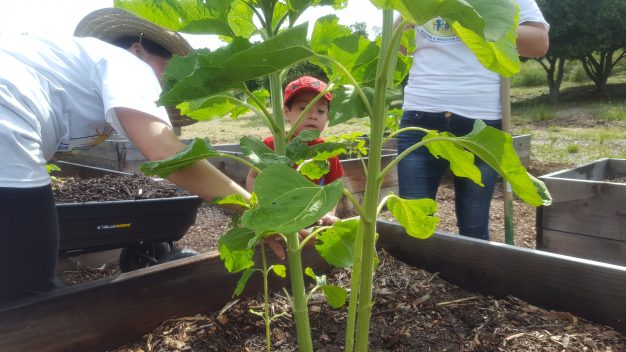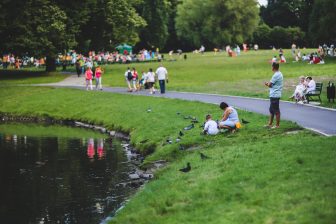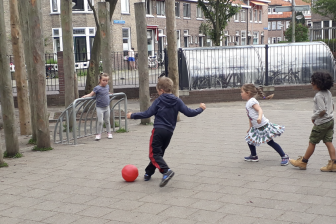
Parks as sites for belonging
Parks are vital spaces for children’s play and sense of place, as well as being important spaces for the health and restoration of the whole community. But a recent study of ethnic minorities (Das et al. 2017) found that foreign-born residents, blacks and Latinos experience particular barriers to their use of parks, including foreign culture, language and not feeling welcome. In the first of this two-part article, Jordin Simons and Victoria Derr consider how a park in Salinas, California supports memory-making and a sense of belonging for the whole community.
Das and colleagues (2017) emphasize that for people to use them, parks not only need to be safe, welcoming, and attractive, but they also need to “encourage a sense of community.” One means of promoting this is to understand parks as sites for belonging (Main 2012), and this is especially so for children.
Children of all ages need places for security, social affiliation, and exploration (Derr 2002). But how do communities with high crime and gang violence create such spaces? One means to do this is by restoring degraded landscapes into vibrant greenspace.
In the city of Salinas, dedicated community members and university faculty members have supported the restoration of Natividad Creek Park over several years of community-based restoration efforts through Return of the Natives. While Natividad Creek was once straightened as an irrigation ditch, and later became a site for dumping, channeling, and paving, now it is a space for Sunday afternoon soccer games and birthday celebrations, a space for cultivating relationships and building community ties. The community has adapted the spaces to fit their unique cultural and social needs, making it a place where many young people come to avoid crime and violence.
Placemaking reflects community history and values
One community leader, Daniel, spoke about the park as he walked under the shade of the tall oak trees, pointing to a few picnic tables, as his face lit up, “I remember having birthdays there, with my sisters. My dad would make tacos and hang a piñata.”
Daniel’s sister, Leti, started a community garden at the park. With the help of her sisters, brother, husband and children they have been able to construct raised garden beds now filled with sunflowers and vegetable plants. Leti said that she loves the space and wants her kids to have a place to experience nature and learn about their food. She and Daniel have plans to add a children’s learning lab that will undoubtedly inspire the next generation of environmental stewards.
I come to stay out of trouble
– Brian
The park also provides a safe haven for some Salinas youth. One such youth was skating by, while Jordin worked in the garden. He hesitantly walked over and sat at the garden’s edge in the tall grass, watching her pull weeds from the lettuce bed. Smiling, Brian explained that he liked to run the park trails to stay in shape and was learning how to skateboard “over there,” pointing to the concrete bowl and jump rails. He told her that it was easy to get caught up with the wrong crowd, referring to the gangs. “I come to stay out of trouble.
Intergenerational connection
Brian also spoke about when his mother first immigrated to the Valley: “She says it’s changed a lot in 30 years, there wasn’t all the cool plants before” he said, motioning to the abundance of native foliage that Return of the Natives had re-introduced to the area. This park created a space for Brian to share an intergenerational connection with his mother, who had utilized the park decades before him.
However residents choose to utilize Natividad Creek Park, it is clear that it has become an asset to the community. The experiences mentioned above are just a few of the memories that shape individual identities and establish a community setting for belonging. There is a sense of place in the park, where Latino residents can integrate their broader cultural values of family and identity to create a space where relationships take shape.
(To be continued)
Jordin Simons and Victoria Derr
Jordin Simons is a student at California State University Monterey Bay and spent much of her spring semester working in the community garden at Natividad Creek Park.
Victoria Derr is an Assistant Professor in Sustainability Education at CSUMB.
Photo: Jordin Simons
References
Das, K.V., Fan, Y., & French, SA, 2017. Park-Use Behavior and Perceptions by Race, Hispanic Origin, and Immigrant Status in Minneapolis, MN: Implications on Park Strategies for Addressing Health Disparities. Journal of Immigrant and Minority Health 19(2), 318-327.
Derr, V. 2002. Children’s sense of place in northern New Mexico. Journal of Environmental Psychology, 22(1), 125-137.
Main, K. 2012. Public Space Attachments in Latino and Immigrant Communities: A Case Study of MacArthur Park. Pp. 83-97 in Rios, Michael, and Leonardo Vazquez, eds. Dialogs: placemaking in Latino communities. Routledge.




